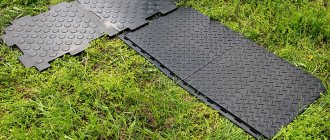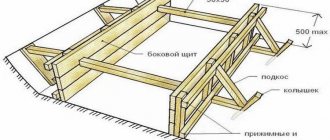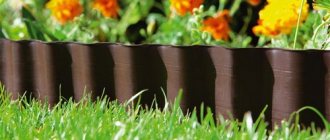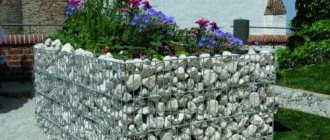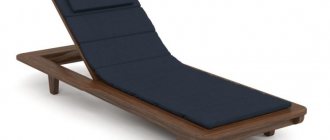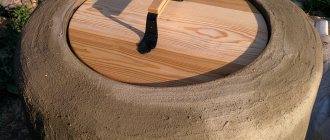Order work
From 990 rub/sq. m
In order to prevent trampling of the lawn, so as not to get your shoes dirty during the rainy season, it is better to make paths in a suburban area. We offer turnkey paving of garden paths with a competitive price for the work. You can find out how much it costs to lay paving stones in Moscow, as well as clarify the cost per m2 of various coating options by contacting us by phone.
There are many options, but the most common are the following:
- Laying paving stones on a sandy base.
- Paths and parking areas made of monolith.
- Pouring a monolithic base and laying tiles on an adhesive base.
- Paths and parking areas made of fine crushed stone.
Constructive
When choosing a material for a path, one takes into account several factors, including the type of soil, the groundwater level, the expected cross-country ability, and the type of path. In addition, the financial side of the issue is also important - how much will a square meter of coating cost and whether it can be laid independently, without the involvement of hired workers. The durability of the track, its reliability, and maximum permissible loads depend on the technical characteristics of the coatings themselves. Another basic parameter influencing the choice is the length of the route. For a track of ten meters, it is realistic to purchase expensive, labor-intensive raw materials, but when aiming at a “highway” of a hundred meters, they think about reducing the cost and simplifying the process of creating the canvas.
If, when choosing a type of path, the first consideration is practicality and accessibility, choose a straight form.
It will require less material, and installation will not pose any particular difficulties. When decorativeness is of paramount importance, or the terrain of the site does not allow laying the route straight, they resort to radial, curved or fancy forms. An option that allows you to combine practicality with decorativeness - a combination of straight and fantasy forms, taking into account the purpose and parameters of the paths. For example, make the main path from the main entrance to the house straight, as strong and reliable as possible, and make the secondary paths connecting other buildings and zones with a “zest”, curved, from original materials.
To make it easier to choose the shape of the path and the covering material, draw a sketch with the layout of the site - it is clearly easier to choose an option that suits all parameters. Using a computer graphics editor, you can get an image as close as possible to the future original and correct all controversial issues. This is easier than realizing during the excavation process that the radial path to the gazebo does not fit into the landscape. Forum member Anikey turned to a professional for help.
Anikey FORUMHOUSE Member
I started with the planning of the site, the plan was made by a landscape designer, and as a result I came up with a project, according to which part of the site was allocated for construction, and another part could be used for landscaping. It was decided to begin the improvement by planting the plants that were on the developed plan and installing paths.
Contacting a designer is an option, but it’s far from the only one; you can zone everything yourself in the editor, and forum members, always ready to respond to a call for help, will give you ideas and share their experience in specialized topics.
Rubber plates for paving paths
One type of paving material that is gaining popularity is rubber. Most often it is used for paving children's and sports grounds, the perimeter around the pool and piers.
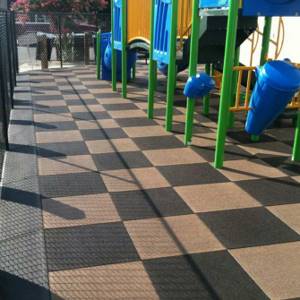
Rubber coating has many advantages:
- Resistance to any weather conditions. Rubber perfectly withstands active ultraviolet radiation, frequent rains and even temperatures down to -45 degrees, without fading or fading.
- No slipping. Even in severe frosts, ice does not form on rubber plates.
- It has great mechanical strength and is not subject to deformation and corrosion.
- Resistance to aggressive chemicals.
- Rubber is resistant to mold and mildew.
- Thanks to this coating, access of air and moisture to the roots is maintained. The load on the soil is distributed evenly, which is why the root system of plants is not suppressed.
- Rubber tiles can be laid both on loose surfaces and on a solid base.
- Variety of shapes and colors.
Popular varieties
Although rich imagination and ingenuity allow summer residents to make paths from almost any available raw material, there are several types of materials that are consistently popular.
Paving slabs
Modern paving slabs, made by vibration casting or vibrocompression, are characterized by high strength, wear resistance, durability and decorativeness. On sale there is a huge selection of tiles of different shapes, sizes and colors, which allows you to choose a material to your liking that will organically fit into the design of the site. The tiles are made on the basis of concrete, with the addition of various modifiers, and there are inclusions of natural stones (marble and granite chips). Small businesses can make a batch of tiles to order if you need an original color or texture, but this is expensive.
In order for the tile to last for the fifteen years declared by the manufacturer (for most categories), when choosing, it is necessary to rely on the relationship between the thickness of the material and the maximum loads.
For paving pedestrian paths and adjacent areas, a thickness of 40 mm is sufficient, but if loads will be transported along the path, or it is a driveway, the minimum thickness will be 60 mm. Users of our portal also use tiles, although the process of installing them independently over large areas is certainly not easy.
personForumHouse Member
I already knew that I would lay tiles on my site when I started building the house. Over the past two years, the plan for all communications, paths and lawns has been finally formed, and the curbs have been cast. The bulk sand had managed to compact, which was getting pretty boring because it was dragged into the house on shoes. And now the moment of truth has come.
Igor_3000FORUMHOUSE Member
I laid tiles of 110 m² myself and I know how it really is - this process is labor-intensive, I laid the tiles on the screenings, I myself dragged 4 KamAZ screenings around the yard, tore off the concrete floor and laid the tiles. No one would believe me if I told you, and I myself don’t believe that I did it. I laid vibro-pressed tiles simply for screening without a DSP, 1 year has passed, there are no failures anywhere.
A natural stone
Several natural rocks are used for paving paths and adjacent areas, but flagstone is most often used - a type of sandstone, otherwise called “wild stone”, or plaster, which you can learn more about in the article “Facing by nature...”. They can be laid either in its original form, with random chips, or processed, chipped or tumbled (machine sanded, with a rounded edge). The main color scheme is gray-green with nuanced shades, the surface of the stone is rough.
Flagstone is superior in strength and durability to artificial tiles and is not inferior to it in terms of decorativeness; if desired, entire patterns can be laid out on the paths.
But even by simply adjusting the segments, an exclusive, original coating is obtained. As in the case of concrete tiles, when choosing, they rely on the thickness: for footpaths 30 mm is enough, for driveways - from 40 mm. And flagstone found its admirers among our users.
Michael82FORUMHOUSE Member
I made these paths, took 30-40 mm plastic, and used a thinner one for finishing the house. I prefer a concrete base with reinforcement and planting it on glue; I personally don’t like it on a sand bed.
MortajForumHouse Member
First, I tiled the patio for testing and laid it on a sand and gravel cushion. Two years have passed - it stands perfectly, not a single stone has moved, which convinced me that the choice was correct. I will continue paving the yard, paths, driveways, I want a natural covering for the garden in the Mediterranean style.
Concrete monolith
One of the cheapest materials for garden paths is concrete, which is widely used for alleys, adjacent areas, and driveways.
It is universal, requires minimal financial costs, and low decorativeness can be compensated for with imagination. By adding fine gravel or marble chips, you can get a coating that is not inferior in appearance to finished tiles. And even without additives, the surface can be given the appearance of tiles or wild stone by applying false seams, or the surface can be sanded to look like granite. As in other cases, the thickness of the layer depends on the expected loads. Path for pedestrian travel - from 50 mm, if a loaded wheelbarrow is driving - from 80 mm. The most common method of making concrete paths is continuous pouring of the entire footage. However, Denis, a new forum member, deviated from the standards - he made both a decorative and durable path, pouring concrete in segments.
Denis newForumHouse Member
The site was more like a swamp - I brought seventeen KamAZ trucks of soil, scattered it with a garden wheelbarrow in a couple of weeks, but it was scary to fall into the loose soil. Therefore, I quickly dug holes, about a meter long, I don’t remember how many, but 30 cm high, threw in a little sand, crushed stone, broken brick, then a metal mesh (left over from the construction of the house) and filled it with concrete. I quickly removed the soil (excess for trees) and planted it with lawn grass - it all took four days.
More than three years have passed since the filling and, according to the craftsman, the path retains its integrity and decorativeness. The resulting slabs are more reminiscent of natural stone than concrete; this effect was achieved by a yellow pigment lying around in the garage, added “just in case.”
Homemade paving slabs
As in production, concrete with modifying additives is used in its production; the color scheme depends on the added pigment. Polymer molds for pouring are sold everywhere - in construction stores, hypermarkets, and they can be ordered online. The tiles are cast either in advance, in preparation for work on the design of the path, or directly onto the prepared base. In this case, the coating “grows” section by section. In addition to standard ready-made forms, many craftsmen adapt their favorite containers for tiles, using burdock leaves, Bigfoot footprints and other original sources as a basis.
Even when using a standard template, the tile turns out to be exclusive - everyone makes the composition in their own way, adding different plasticizers. The coloring is individual; many decorate the top of homemade products with pebbles, mosaics and similar elements.
The service life of homemade tiles is lower than that of purchased ones (if we are not talking about counterfeit ones), since the production uses a vibration process that increases the strength of the connection between the components. When casting a path on site, this effect cannot be achieved, but if you make the tiles in advance and use a homemade vibrating table, the product will not be inferior in quality to a purchased one. Forum members mastered the process of making paving slabs with their own hands.
BaksruFORUMHOUSE Member
I made the sidewalk paths myself from self-mixed materials (cement, sand). I made the mold for pouring cement myself from penofol, a centimeter thick, and cut it into equal strips of 6 cm/1 m.
Diman72FORUMHOUSE Member
I decided to make paving stones for the dacha myself, fortunately there are 50 molds, I dug up an IV vibrator in my father’s garage - I don’t remember the exact number, so I’ll build a table.
Wood
Although wood is inferior to stone in durability and practicality, it is no less popular as a covering for garden paths. Usually, flooring is made on joists from crossbars, or round timber cuts are dug into the ground, the wood is pre-treated with protective compounds. Such paths can be pedestrian or for household needs; they will withstand the weight of a wheelbarrow, but are not suitable as driveways. Another variation is decking, or decking board; it has a long service life and an original appearance, but the cost is impressive. Typically, wooden walkways are stationary, laid in their place and last for several years. But one of the forum members came up with a mobile flooring that can be installed and removed anywhere as needed.
Izya123FORUMHOUSE Member
Planks and a fire hose - a path so as not to spoil the grass, or when there is bad weather and mud. The planks are screwed to the hose through a template using oxidized (possibly stainless) self-tapping screws.
Bulk fractions
Among natural materials for finishing backfill, gravel (screening) is the most durable and practical; coarse sand is less often used. It is even less common to cover the canvas with sawdust or mulch, since these materials quickly erode and require constant topping. On secondary paths, which serve more as decoration, backfill is alternated with tiles or stones to increase decorativeness.
The key to the durability of a gravel path is the correct preparation of the base and layer-by-layer backfilling with compaction or vibration compaction of each layer.
Portal user Kolos75 filled both the paths and the driveway with gravel, turning the swampy, overgrown area into a cozy yard.
Kolos75FORUMHOUSE Member
We make paths at the dacha: we dug a pit, laid it with geotextiles and covered it with crushed stone in a layer of about 10 cm. We plan the final covering from granite screenings.
The total improved area was 60 m², 10 mᶟ of crushed stone and the same amount of granite screenings were used, plus a couple of rolls of geotextiles, drainage pipes and 40 linear meters of curb tape. Read more about curbs in the material “Curbs - decent edging and protection for paths.” Kolos75 worked alone, sometimes involving his wife, the process is difficult, but the result is worth it.
Paving materials
Landscape design continues to evolve, offering more and more materials for paving paths. Now the choice is so wide that many find it difficult to decide what to choose for their site.
Based on manufacturing technology, the types of paving paths are as follows:
- Hard - paving made of natural stone, clinker brick, concrete, wood, asphalt and the like. This type of coating is the most popular.
- Soft. They use bulk materials such as sand, crushed stone, gravel, and so on.
- Combined. The essence is a combination of the two types of coatings mentioned above - hard and soft.
- Special - a coating that requires the use of complex production technologies. This can be decorative concrete or green paths
When choosing a certain type of paving for garden paths, you need to familiarize yourself with their characteristics, as well as take into account all operational requirements. Next, we will consider in more detail some types of coverage.

